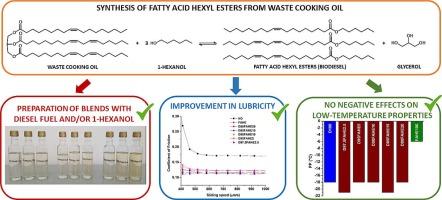脂肪酸己酯:合成反应参数和柴油-生物柴油-1-己醇混合物成分对应用特性的影响
IF 6.7
1区 工程技术
Q2 ENERGY & FUELS
引用次数: 0
摘要
本研究的主题是反应参数--温度(40-80 °C)、时间(2-60 分钟)、1-己醇与废弃食用油的摩尔比(5:1-12:1)以及 KOH 催化剂的质量分数(1-3 wt%)--对脂肪酸己酯(FAHE)合成(即反应转化率)的影响。随后,合成、提纯了更大量的生物柴油,并将其与 1-己醇和无添加矿物柴油混合,以评估混合燃料的应用特性,作为柴油发动机中可能使用的运输燃料。生物柴油的体积分数增加到 20% 时,其密度、粘度和表面张力值都会增加。相反,添加 1- 己醇至 15% 会导致这些值下降。柴油-生物柴油混合物的低温特性(如倾点、浊点和燃烧热)与矿物柴油相同或非常接近,而 FAHE 则显著改善了柴油的润滑特性。总之,所制备混合燃料的应用特性值符合 EN 590 标准规定的相应准则。本文章由计算机程序翻译,如有差异,请以英文原文为准。

Fatty acid hexyl esters: Influence of the reaction parameters on the synthesis and diesel-biodiesel-1-hexanol blend composition on the application properties
The matter of this study is the influence of reaction parameters – temperature (40–80 °C), time (2–60 min), molar ratio of 1-hexanol to waste cooking oil (5:1–12:1), and mass fraction of KOH catalyst (1–3 wt%) – on the synthesis, i.e. reaction conversion, of fatty acid hexyl esters (FAHE). Afterward, larger amounts of biodiesel were synthesized, purified, and blended with 1-hexanol and non-additized mineral diesel, to assess blends’ application properties, as possible transportation fuels used in diesel engines. An increase in biodiesel’s volume fraction up to 20 vol% in blends led to an increase in their densities, viscosities, as well as surface tension values. On the contrary, adding 1-hexanol up to 15 vol% resulted in a decrease in these values. Low-temperature properties of diesel–biodiesel blends, e.g. pour point and cloud point and heat of combustion were the same or very close to those of mineral diesel, whereas FAHE significantly improved lubricating properties of diesel. Altogether, application property values of the prepared blends fell within the corresponding guidelines set by the standard EN 590.
求助全文
通过发布文献求助,成功后即可免费获取论文全文。
去求助
来源期刊

Fuel
工程技术-工程:化工
CiteScore
12.80
自引率
20.30%
发文量
3506
审稿时长
64 days
期刊介绍:
The exploration of energy sources remains a critical matter of study. For the past nine decades, fuel has consistently held the forefront in primary research efforts within the field of energy science. This area of investigation encompasses a wide range of subjects, with a particular emphasis on emerging concerns like environmental factors and pollution.
 求助内容:
求助内容: 应助结果提醒方式:
应助结果提醒方式:


